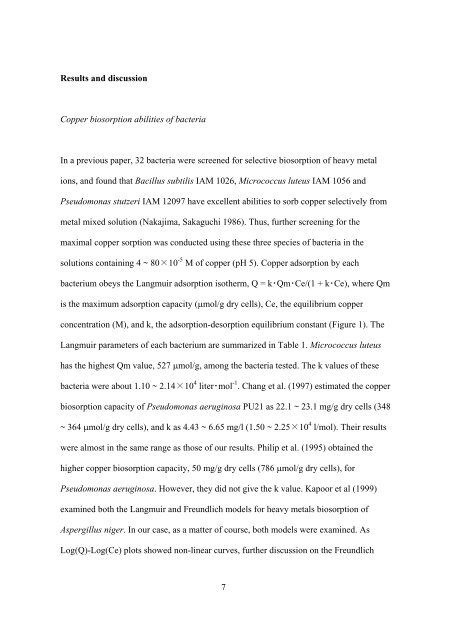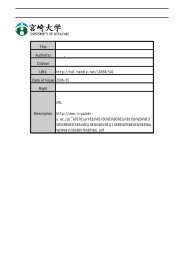Micrococcus luteus - 宮崎大学
Micrococcus luteus - 宮崎大学
Micrococcus luteus - 宮崎大学
Create successful ePaper yourself
Turn your PDF publications into a flip-book with our unique Google optimized e-Paper software.
Results and discussion<br />
Copper biosorption abilities of bacteria<br />
In a previous paper, 32 bacteria were screened for selective biosorption of heavy metal<br />
ions, and found that Bacillus subtilis IAM 1026, <strong>Micrococcus</strong> <strong>luteus</strong> IAM 1056 and<br />
Pseudomonas stutzeri IAM 12097 have excellent abilities to sorb copper selectively from<br />
metal mixed solution (Nakajima, Sakaguchi 1986). Thus, further screening for the<br />
maximal copper sorption was conducted using these three species of bacteria in the<br />
solutions containing 4 ~ 80×10 -5 M of copper (pH 5). Copper adsorption by each<br />
bacterium obeys the Langmuir adsorption isotherm, Q = k・Qm・Ce/(1 + k・Ce), where Qm<br />
is the maximum adsorption capacity (μmol/g dry cells), Ce, the equilibrium copper<br />
concentration (M), and k, the adsorption-desorption equilibrium constant (Figure 1). The<br />
Langmuir parameters of each bacterium are summarized in Table 1. <strong>Micrococcus</strong> <strong>luteus</strong><br />
has the highest Qm value, 527 μmol/g, among the bacteria tested. The k values of these<br />
bacteria were about 1.10 ~ 2.14×10 4 liter・mol -1 . Chang et al. (1997) estimated the copper<br />
biosorption capacity of Pseudomonas aeruginosa PU21 as 22.1 ~ 23.1 mg/g dry cells (348<br />
~ 364 μmol/g dry cells), and k as 4.43 ~ 6.65 mg/l (1.50 ~ 2.25×10 4 l/mol). Their results<br />
were almost in the same range as those of our results. Philip et al. (1995) obtained the<br />
higher copper biosorption capacity, 50 mg/g dry cells (786 μmol/g dry cells), for<br />
Pseudomonas aeruginosa. However, they did not give the k value. Kapoor et al (1999)<br />
examined both the Langmuir and Freundlich models for heavy metals biosorption of<br />
Aspergillus niger. In our case, as a matter of course, both models were examined. As<br />
Log(Q)-Log(Ce) plots showed non-linear curves, further discussion on the Freundlich<br />
7




